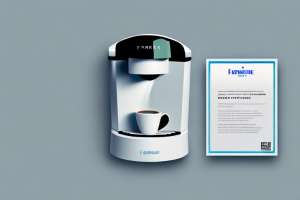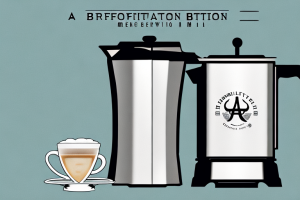Cleaning A Cuisinart Coffee Maker

A cuisinart coffee maker with cleaning supplies around it
A Cuisinart coffee maker can be a valuable addition to any coffee lover’s kitchen, but like any appliance, it requires regular maintenance to ensure optimal performance and longevity. In this article, we will explore why cleaning your Cuisinart coffee maker is important, what you need to clean it, how to clean it step-by-step, how often you should clean it, tips for maintaining it, deep cleaning, using vinegar, and troubleshooting common issues.
Why Cleaning Your Cuisinart Coffee Maker is Important
Cleaning your Cuisinart coffee maker is crucial because it ensures that your coffee tastes great, and it prevents any buildup that could clog the machine or affect its performance. Coffee makers can harbor bacteria and other impurities, which can cause odors, mold, and other health issues over time.
Additionally, regular cleaning of your Cuisinart coffee maker can extend its lifespan and save you money in the long run. Neglecting to clean your coffee maker can lead to mineral buildup, which can damage the machine and require costly repairs or replacements.
Furthermore, cleaning your Cuisinart coffee maker is a simple and easy process that only takes a few minutes. Most models come with a cleaning cycle or instructions on how to clean the machine with vinegar or other cleaning solutions. By taking the time to clean your coffee maker regularly, you can enjoy a delicious cup of coffee every morning and ensure that your machine lasts for years to come.
What You Need to Clean Your Cuisinart Coffee Maker
You will need some simple tools to clean your Cuisinart coffee maker, including a cleaning solution, a bowl, white vinegar, a damp cloth, and a coffee filter.
Before you begin cleaning your Cuisinart coffee maker, make sure to unplug it and let it cool down completely. This will prevent any accidents or injuries while cleaning.
It is recommended to clean your Cuisinart coffee maker at least once a month to ensure that it functions properly and produces great-tasting coffee. Regular cleaning also helps to remove any buildup of mineral deposits, coffee oils, and other impurities that can affect the quality of your coffee.
Step-by-Step Guide to Cleaning Your Cuisinart Coffee Maker
Here is a step-by-step process to clean your Cuisinart coffee maker:
- Turn off the coffee maker and unplug it from the outlet.
- Remove any leftover coffee from the carafe and discard it.
- Fill the carafe with equal parts of water and vinegar.
- Pour the solution into the coffee maker’s water reservoir.
- Place the coffee filter in the basket and turn on the machine.
- After the cycle is complete, rinse the carafe, basket, and coffee maker thoroughly with water.
- Repeat the process with pure water, without adding any vinegar.
- Wipe down the machine’s exterior with a damp cloth.
It is recommended to clean your Cuisinart coffee maker every 1-3 months, depending on how often you use it. Regular cleaning helps to remove any buildup of mineral deposits, coffee oils, and other impurities that can affect the taste of your coffee and the performance of your machine. If you notice any unusual smells or tastes in your coffee, it may be a sign that your coffee maker needs to be cleaned.
How Often Should You Clean Your Cuisinart Coffee Maker?
It is recommended to clean your Cuisinart coffee maker after every use, but deep cleaning should be done every three to six months.
Regular cleaning of your Cuisinart coffee maker is essential to ensure that it continues to function properly and produce great-tasting coffee. After each use, you should remove the used coffee grounds and rinse the carafe and filter basket with warm, soapy water. This will help to prevent the buildup of oils and residue that can affect the flavor of your coffee.
Deep cleaning your Cuisinart coffee maker every three to six months is also important. This involves descaling the machine to remove any mineral buildup that can occur over time. To do this, you can use a mixture of equal parts water and white vinegar, which should be run through the machine as if you were making a pot of coffee. Be sure to follow the manufacturer’s instructions for your specific model.
Tips for Maintaining Your Cuisinart Coffee Maker
Maintaining your Cuisinart coffee maker can help extend its lifespan and keep it working efficiently. Some simple tips include:
- Use only fresh filtered water.
- Don’t leave water or coffee grounds in the machine for long periods.
- Store your coffee maker in a dry place when not in use.
- Replace the machine’s filter regularly.
Another important tip for maintaining your Cuisinart coffee maker is to clean it regularly. This includes wiping down the exterior with a damp cloth and cleaning the carafe and filter basket after each use. You can also run a cleaning cycle with a mixture of water and vinegar to remove any buildup inside the machine.
It’s also a good idea to descale your coffee maker every few months. This involves running a descaling solution through the machine to remove any mineral buildup that can affect the taste of your coffee. Follow the instructions in your user manual for the best results.
Deep Cleaning Your Cuisinart Coffee Maker: When and How to Do It
A deep cleaning should be done every three to six months or when the coffee maker has not been cleaned in a while. The instructions for deep cleaning your Cuisinart coffee maker are similar to regular cleaning, but with a more thorough approach. It is essential to read the instructions that came with your specific machine.
During a deep cleaning, it is recommended to use a descaling solution to remove any mineral buildup in the machine. This buildup can affect the taste of your coffee and even damage the coffee maker over time. To descale your Cuisinart coffee maker, mix equal parts of water and white vinegar and run the machine through a brewing cycle. Then, run two cycles of plain water to rinse out any remaining vinegar. This process should be repeated every three to six months to keep your coffee maker in top condition.
Using Vinegar to Clean Your Cuisinart Coffee Maker: Pros and Cons
Vinegar is an effective and natural way to clean your Cuisinart coffee maker, but it may leave a slight vinegar smell in the machine. Using too much vinegar can also affect the machine’s performance. Dilute the vinegar with equal parts of water.
It is recommended to clean your Cuisinart coffee maker with vinegar every 3-6 months, depending on how often you use it. Regular cleaning can help prevent the buildup of mineral deposits and other impurities that can affect the taste of your coffee. Additionally, using vinegar to clean your coffee maker is an eco-friendly alternative to harsh chemical cleaners that can be harmful to the environment.
How to Remove Stains and Residue from Your Cuisinart Coffee Maker
You can use baking soda and water to remove stubborn stains and debris from your coffee maker. Create a paste of baking soda and water and apply it to the problem area. Let it sit for 10 minutes, and then rinse it off with water.
Another effective way to remove stains and residue from your Cuisinart coffee maker is by using white vinegar. Mix equal parts of white vinegar and water and pour the solution into the water reservoir. Turn on the coffee maker and let the solution run through the machine. Once the cycle is complete, run another cycle with clean water to rinse out any remaining vinegar.
It’s important to regularly clean your coffee maker to prevent buildup and ensure that it continues to function properly. In addition to using baking soda or vinegar, you can also clean the carafe and filter basket with warm soapy water. Be sure to rinse thoroughly and dry completely before using again.
Troubleshooting Common Issues with Your Cuisinart Coffee Maker’s Cleaning Process
If you experience any problems while cleaning your Cuisinart coffee maker, such as leaks or clogs, refer to the manufacturer’s instructions for guidance. If the issue persists, contact customer support.
It is important to note that regular cleaning of your Cuisinart coffee maker can prevent these issues from occurring in the first place. Make sure to clean the machine after every use, and descale it regularly to remove any mineral buildup. Additionally, using high-quality, filtered water can also help prevent clogs and leaks.
Alternative Methods for Cleaning a Cuisinart Coffee Maker
There are other methods to clean your Cuisinart coffee maker, such as using a specialized cleaning product or running the machine with a mixture of lemon juice and water.
Another alternative method for cleaning your Cuisinart coffee maker is to use white vinegar. Simply fill the water reservoir with equal parts white vinegar and water, and run the machine through a brewing cycle. Then, run the machine again with just water to rinse out any remaining vinegar.
It’s important to regularly clean your coffee maker to prevent buildup of mineral deposits and bacteria, which can affect the taste of your coffee and even cause health issues. Whichever method you choose, be sure to follow the manufacturer’s instructions and clean your machine at least once a month.
The Benefits of Regular Cleaning for Better Tasting Coffee
Cleaning your Cuisinart coffee maker regularly not only prevents bacteria and impurities but also helps your coffee taste better. A clean machine produces better-tasting coffee, and it can enhance your overall coffee drinking experience.
Now that you understand the importance of cleaning your Cuisinart coffee maker adequately, follow these easy steps to keep your machine in optimal condition. By following these guidelines, you can enjoy a delicious pot of coffee every time you brew.
Regular cleaning of your coffee maker also extends the lifespan of your machine. Over time, mineral deposits and coffee oils can build up and clog the machine’s internal components, leading to malfunctions and breakdowns. By cleaning your coffee maker regularly, you can prevent these issues and ensure that your machine lasts for years to come.
Additionally, a clean coffee maker can save you money in the long run. When your machine is clogged or dirty, it may not function efficiently, leading to wasted coffee and higher electricity bills. By keeping your coffee maker clean, you can ensure that it operates at peak performance, saving you money on wasted coffee and energy costs.



